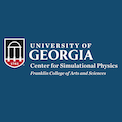Events Calendar View
-
CSP Lunch Seminar
Jan 31, 2017
Pushing the Limits of Monte Carlo Simulations for the 3d Ising Model

Guest: Jiahao Xu, Center for Simulational Physics, University of Georgia
Tuesday, January 31, 2017 12:30 pm - 1:30 pm
Location: CSP Conference Room (322) -
Special Seminar
Feb 3, 2017
LOPA-based direct laser writing of multi-dimensional & multi-functional photonic structures

Guest: Prof. Diep Lai, The Quantum and Molecular Photonics Laboratory (LPQM), Cachan, France
Friday, February 3, 2017 2:00 pm - 3:00 pm
Location: CSP Conference Room (322)We have developed a simple and low-cost fabrication technique, based on low one-photon absorption (LOPA) phenomena in a weakly absorbing photoresist (532 nm laser versus SU8 or S18 photoresist)[1,2,3]. This novel approach enables production of submicrometer 2D and 3D structures and could allow for imaging of submicrometer structures in 3D using a very modest laser power. This technique is also demonstrated as a simple technique to couple a single nanoparticle (nonlinear, metallic, or fluorescent) to polymer-based photonic structures [4,5]. It is recently demonstrated that the LOPA based direct laser writing also allowed to realize as desired plasmonic (gold) and magneto-photonic (Fe3O4) nanostructures [6,7]. Different applications of these fabricated structures could be envisioned, and partially realized, such as tuneable photonic devices, data storage, bright single photon source, quantum information, plasmonic data storage, color nanoprinter.
1. M. T. Do, et al., Submicrometer 3D structures fabrication enabled by one-photon absorption direct laser writing, Opt. Express 21, 20964-20973 (2013).
2. D. T. T. Nguyen, et al., One-step fabrication of submicrostructures by low one-photon absorption direct laser writing technique with local thermal effect, J. Appl. Phys. 119, 013101 (2016).
3. Q. C. Tong, et al., Direct laser writing of polymeric nanostructures via optically induced local thermal effect, Appl. Phys. Lett. 108, 183104 (2016).
4. M. T. Do, et al., Controlled coupling of a single nanoparticle in polymeric microstructure by low one-photon absorption-based direct laser writing technique, Nanotechnology 26, 105301 (2015).
5. D. T. T. Nguyen, et al., Coupling of a single active nanoparticle to a polymer-based photonic structure, J. Science: Advanced Materials and Devices 1, 18-30 (2016).
6. Q. C. Tong, et al., Rapid direct laser writing of desired plasmonic nanostructures, Submitted (2017).
7. T. H. Au, et al., Direct laser writing of magneto-photonic sub-microstructures, Submitted (2016).
-
Observatory Open House
Feb 3, 2017
Observatory Viewing
We will be having another public viewing on February 3, 2017. Because of the limited space in the dome, you must have a reservation to come to this showing. Click here to make a reservation.
The observatory is located at the top of the Physics building. To get to the observatory take the elevator to the 4th floor. A guide will meet you on the 4th floor and direct your group to the stairway that leads to the observatory. As the weather can be unpredictable, we might not know whether a viewing will be possible until shortly before the event begins.
If you need more information please call 706-542-2485.
-
CSP Lunch Seminar
Feb 7, 2017
Prethreshold Quantum Computation
-
Departmental Colloquium
Feb 9, 2017
The World’s Smallest Extreme Laboratories: Probing QED with Highly Charged Ions
Highly charged ions (HCIs) are atoms in which all or most of the electrons have been stripped off. The remaining few (or one) electrons exist in the presence of the strong electric field generated from the nucleus. In the case of fully stripped Uranium this field is 1016 V cm-1, orders of magnitude stronger than any external field available in a laboratory. These ultra strong fields make HCIs ideal mini laboratories in which to test physical theories in extreme conditions.
Quantum Electrodynamics (QED) is an extremely powerful and predictive theory describing the interaction of matter and light especially at low energy. However, in the instances where experimental and theoretical results differ there is an opportunity to study non-standard model physics. HCIs are also promising candidates for next generation atomic clocks and searches for time variation in the fundamental "constants". Additionally, while HCIs are rare on Earth, they are commonplace in the universe, in particularly in the high temperature and pressure environments of stars and solar winds. Understanding how to read the photon signature from interactions of HCIs with neutral gases in the universe gives information on the density, temperature and constituents of both.
-
Departmental Colloquium
Feb 16, 2017
Nanoscopy of Anisotropic Black Phosphorous
Nanolayered and two-dimensional materials such as graphene, boron nitride, transition metal dichalcogenides, and black phosphorus have intriguing physical properties and bear promise of important applications. Of them, black phosphorus has unique electronic properties due to its anisotropic structure and highly tunable band gap both by number of monolayers and by surface doping. I will discuss our recent experimental investigation and theoretically interpretation of anisotropic near-field properties of a few-atomic monolayer nanoflakes of black phosphorus. We have discovered near-field patterns of outside bright fringes and high surface polarizability of nanofilm black phosphorus consistent with its surface-metallic behavior at mid-infrared frequencies. The major impediment to research and prospective application of single/few-layer black phosphorus is its chemical degradation under ambient conditions. I will present our experimental quantification of geometric properties and theoretical modeling of the chemical degradation process of black phosphorus as well as investigation of the effectiveness of passivation coatings using infrared nanoscopy.
Page 71 of 121, showing 6 records out of 723 total, starting on record 421, ending on 426

